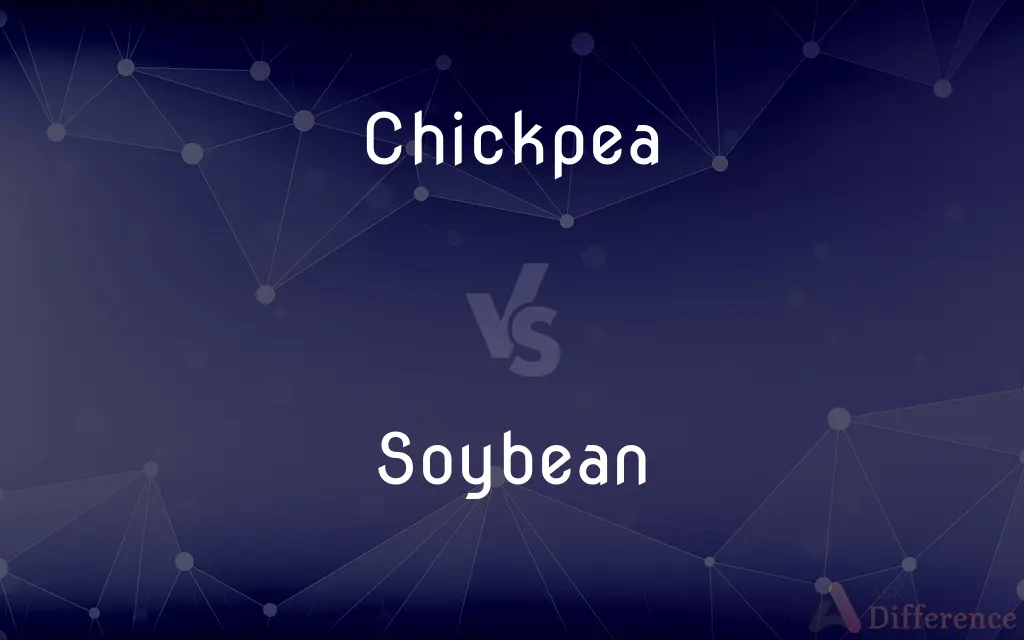Chickpea vs. Soybean — What's the Difference?
By Urooj Arif & Maham Liaqat — Updated on March 19, 2024
Chickpeas are legumes known for their nutty taste and grainy texture, rich in protein and fiber, whereas soybeans are a key source of protein, oil, and lecithin, offering a smoother texture and a more versatile usage in foods and industrial products.

Difference Between Chickpea and Soybean
Table of Contents
ADVERTISEMENT
Key Differences
Chickpeas, also known as garbanzo beans, are versatile legumes that serve as a staple in many diets around the world, particularly in Middle Eastern and Indian cuisines. They are celebrated for their ability to enhance dishes like hummus, salads, and curries with their distinct nutty flavor and satisfying texture. On the other hand, soybeans are incredibly versatile in their applications, not just in culinary contexts—where they appear in products like tofu, soy milk, and soy sauce—but also in industrial products, including biodiesel and plastics, thanks to their high oil content.
Nutritionally, chickpeas offer a rich source of protein, dietary fiber, vitamins, and minerals, supporting digestive health and satiety. Soybeans, while also high in protein, surpass chickpeas in their protein quality and are one of the few plant sources considered a complete protein, containing all nine essential amino acids. Additionally, soybeans are a significant source of essential fatty acids, making them valuable for cardiovascular health.
The cultivation of chickpeas and soybeans also reflects their adaptability to different agricultural environments. Chickpeas thrive in Mediterranean climates and are often grown in rotation with other crops to benefit the soil, whereas soybeans, adaptable to a wide range of climates, are a crucial crop in the United States, Brazil, and Argentina, where they play a key role in both human nutrition and animal feed.
Environmental considerations differentiate the two as well. Chickpeas, like other legumes, have a relatively low water footprint and can enhance soil health by fixing nitrogen, making them an eco-friendly choice. Soybeans, while also nitrogen-fixing, have been at the center of controversies related to deforestation and the use of genetically modified organisms (GMOs) to meet global demand.
The culinary uses of chickpeas and soybeans highlight their distinct characteristics. Chickpeas are often consumed whole, in salads, soups, and stews, or ground into flour for use in various dishes. Soybeans, however, have a broader range of derivatives, including soy milk, tofu, tempeh, and soy protein, showcasing their versatility beyond whole bean consumption.
ADVERTISEMENT
Comparison Chart
Taste and Texture
Nutty flavor, grainy texture
Milder taste, smoother texture
Nutritional Value
High in protein, fiber, vitamins, minerals
Higher protein quality, source of essential fatty acids
Culinary Uses
Hummus, salads, curries, flour
Tofu, soy milk, soy sauce, industrial products
Environmental Impact
Low water footprint, improves soil health
Controversies over deforestation, GMOs
Cultivation
Thrives in Mediterranean climates
Adaptable to a wide range of climates
Applications
Mainly food products
Food and industrial products
Compare with Definitions
Chickpea
Grows well in dry climates, beneficial for crop rotation.
Chickpea cultivation improves soil nitrogen levels.
Soybean
Found in tofu, soy milk, and many processed foods.
Soy milk is a common dairy alternative.
Chickpea
A nutrient-rich legume with a nutty flavor, used in various cuisines.
Chickpeas are essential for making creamy hummus.
Soybean
Associated with GMO concerns and deforestation.
Sustainable soy farming practices are being promoted.
Chickpea
Offers protein, fiber, and essential nutrients for health.
Adding chickpeas to salads boosts fiber intake.
Soybean
A versatile legume used in food products and industry.
Soybeans are processed into tofu and soy milk.
Chickpea
Versatile in dishes from salads to soups and baking.
Chickpea flour is popular in gluten-free recipes.
Soybean
A complete protein source with essential fatty acids.
Soybeans are a dietary staple in vegan protein sources.
Chickpea
Requires less water, making it an eco-friendly crop.
Chickpeas are a sustainable option in water-scarce areas.
Soybean
Widely grown globally, with uses in food and feed.
The U.S. is a leading producer of soybeans.
Chickpea
An annual Asian plant (Cicer arietinum) in the pea family, widely cultivated for the edible seeds in its short inflated pods.
Soybean
The soybean, soy bean, or soya bean (Glycine max) is a species of legume native to East Asia, widely grown for its edible bean, which has numerous uses. Traditional unfermented food uses of soybeans include soy milk, from which tofu and tofu skin are made.
Chickpea
The chickpea or chick pea (Cicer arietinum) is an annual legume of the family Fabaceae, subfamily Faboideae. Its different types are variously known as gram or Bengal gram, garbanzo or garbanzo bean, or Egyptian pea.
Soybean
An annual leguminous plant (Glycine max) native to East Asia, widely cultivated for its seeds, which are used for food, as a source of oil, and as animal feed.
Chickpea
A seed of this plant. In both senses also called garbanzo.
Soybean
A seed of this plant.
Chickpea
An annual Asian plant (Cicer arietinum) in the pea family, widely cultivated for the edible seeds in its short inflated pods.
Soybean
A legume plant (Glycine max), commonly cultivated for human and animal consumption and as a nitrogen-fixing ground cover.
Chickpea
A seed of this plant, often used as a food.
Chickpea is valued for its nutritive seeds with high protein content.
Soybean
The edible seed of this plant.
Chickpea
The seed of the chickpea plant
Soybean
An Asiatic leguminous herb (Glycine max, formerly Glycine Soja) the seeds of which (also called soy beans) are used in preparing the sauce called soy. Called also soya bean and soya.
Chickpea
Asiatic herb cultivated for its short pods with one or two edible seeds
Soybean
The seeds of the Glycine max, which produce soybean oil; - called also soya bean.
Chickpea
Large white roundish Asiatic legume; usually dried
Soybean
A source of oil; used for forage and soil improvement and as food
Soybean
Erect bushy hairy annual herb having trifoliate leaves and purple to pink flowers; extensively cultivated for food and forage and soil improvement but especially for its nutritious oil-rich seeds; native to Asia
Soybean
Most highly proteinaceous vegetable crop known
Common Curiosities
Can chickpeas and soybeans be used interchangeably in recipes?
While both are legumes, their different textures and flavors mean they're not always interchangeable, but both can contribute protein to vegetarian and vegan dishes.
Why are soybeans important?
Soybeans are a vital source of protein, oil, and lecithin, used widely in food products, animal feed, and industrial applications.
How do the nutritional profiles of chickpeas and soybeans compare?
Both are high in protein, but soybeans offer a higher quality of protein and essential fatty acids, making them slightly more nutritious in these aspects.
How can I incorporate chickpeas into my diet?
Incorporate chickpeas into salads, soups, stews, or snack on roasted chickpeas for a nutritious boost.
What are chickpeas good for?
Chickpeas are great for adding protein, fiber, and nutrients to the diet, and they're versatile in dishes like hummus and salads.
Are chickpeas or soybeans better for the environment?
Chickpeas generally have a lower environmental impact, requiring less water and improving soil health, whereas soybeans have faced issues with deforestation and GMOs.
Is there a health concern with consuming soy products?
While soy products are generally safe and healthy, individuals with specific health conditions or concerns should consult with a healthcare provider regarding soy consumption.
What's the environmental controversy around soybeans?
The controversy stems from the large-scale cultivation of soybeans leading to deforestation and the widespread use of GMOs in soy production.
What are the main uses of chickpeas?
Chickpeas are mainly used in culinary applications, including in salads, stews, and as flour in baking.
What products are made from soybeans?
Soybeans are used to make tofu, soy milk, soy sauce, and are also found in many processed foods and industrial products.
Share Your Discovery

Previous Comparison
Ostrich vs. Rhea
Next Comparison
Honest vs. HonestlyAuthor Spotlight
Written by
Urooj ArifUrooj is a skilled content writer at Ask Difference, known for her exceptional ability to simplify complex topics into engaging and informative content. With a passion for research and a flair for clear, concise writing, she consistently delivers articles that resonate with our diverse audience.
Co-written by
Maham Liaqat














































